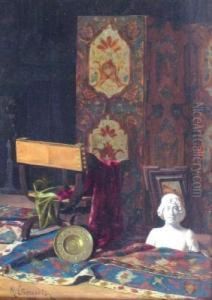Klavdyi Petrovich Stepanov Paintings
Klavdyi Petrovich Stepanov was a notable Russian and Soviet graphic artist and sculptor, born on October 13, 1892, in the village of Pokrovskoye in the Ryazan Governorate of the Russian Empire. His work was significantly influenced by the socio-political climate of his era, particularly the October Revolution and the subsequent developments in the Soviet Union.
Stepanov's early life was spent in his birthplace, but he later moved to Moscow to pursue his artistic education. He studied at the Stroganov Moscow State University of Arts and Industry, where he developed his skills in graphic arts and sculpture. His education was interrupted by World War I and the Russian Civil War, during which he served in the army. The experiences during these turbulent times had a profound impact on his artistic vision.
In the 1920s, Stepanov became deeply involved with the avant-garde movement, which sought to break away from the traditional forms of art and embrace the revolutionary spirit of the new Soviet society. His work from this period was characterized by dynamic compositions, a bold use of line, and a commitment to the Constructivist ethos, which emphasized art's practical function in social transformation.
During the 1930s, Stepanov's work began to reflect the aesthetic of Socialist Realism, the officially sanctioned style of art in the Soviet Union. This style emphasized realistic, heroic portrayals of workers and peasants, showcasing the triumphs of socialism. Stepanov's graphics and sculptures from this period often depicted laborers, soldiers, and Soviet leaders, contributing to the visual culture that aimed to inspire and educate the masses.
Throughout his career, Stepanov worked on various projects, including propaganda posters, book illustrations, and public monuments. He was also a teacher, imparting his knowledge and skills to the next generation of Soviet artists. Despite the constraints imposed by the state on artistic expression, Stepanov managed to maintain a level of personal creativity within his works.
Klavdyi Petrovich Stepanov's contributions to Soviet art were recognized by the state, and he was awarded various honors throughout his career. He continued to work until his death on September 17, 1951. His art remains a testament to the complex interplay between individual creativity and the ideological demands of the time in which he lived.
